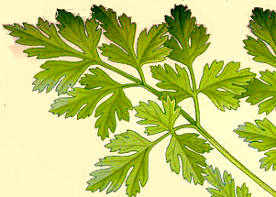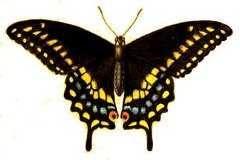 Petroselinum
crispum
Petroselinum
crispumParsley, Italian Flat
In ancient Greece, wreaths of parsley decorated tombs; it was the herb of the Styx ferryman, Charon. That's the source of the Greek saying "to need parsley" (to be near death). Parsley is said to have arisen from the blood of Archemorus, a child who was killed by a serpent when left alone by his nurse. This character of Greek myth is primarily a symbol foretelling death as the outcome of an endeavor. On the other hand, Hercules made himself wreaths from parsley, so this herb wasn't all funereal. It wasn't eaten at that time but was grown in gardens as a border along with rue; this could be why the Romans then went on to use wreaths of parsley and rue to keep away evil spirits (so consider planting parsley as ward around your property). In connection with this, in Christianity, the best day to plant parsley is Good Friday, the day Jesus was executed and descended into the Christian underworld. Suitably enough, parsley is a Mercury herb; this deity spent some of his time guiding the souls of the dead to the Underworld, which fits this herb so well, but its finely divided leaves are also considered classic Mercury-type leaves. For these reasons, I think this herb makes a fine helper for those who work with the dead. Top
 In England, folk belief is that parsley goes seven
times to the Devil
(or "Old One") and back before it germinates. Perhaps this is why it is
considered bad luck to transplant it. In other areas of Britain, it was
said that only a witch can germinate parsley. It certainly shows that
whoever is growing it must have a way with plants, as it requires
patience to
germinate it. And of course, parsley was an ingredient in some flying
ointments, presumably because it gives a lasting green color but
perhaps also because of its Underworld connections. In Britain it was
considered an offense
to the ruling spirit of parsley to transplant a bed; this belief was
also held by African Americans in the nineteenth century. In the
Fenlands, parsley was planted at night in rows aligned with the
Pole Star and the Plough (the Big Dipper); in spring, this is
basically planting in rows running north and south. Along these
lines, in Cambridgeshire folks were advised to start parsley on the New
Moon, the time of full dark. Top
In England, folk belief is that parsley goes seven
times to the Devil
(or "Old One") and back before it germinates. Perhaps this is why it is
considered bad luck to transplant it. In other areas of Britain, it was
said that only a witch can germinate parsley. It certainly shows that
whoever is growing it must have a way with plants, as it requires
patience to
germinate it. And of course, parsley was an ingredient in some flying
ointments, presumably because it gives a lasting green color but
perhaps also because of its Underworld connections. In Britain it was
considered an offense
to the ruling spirit of parsley to transplant a bed; this belief was
also held by African Americans in the nineteenth century. In the
Fenlands, parsley was planted at night in rows aligned with the
Pole Star and the Plough (the Big Dipper); in spring, this is
basically planting in rows running north and south. Along these
lines, in Cambridgeshire folks were advised to start parsley on the New
Moon, the time of full dark. TopParsley is linked to women in a number of ways. There is the British belief that parsley will stay green all year round outside the home where the wife is the boss. In the Fenlands it was even thought that if a woman's garden grew copious parsley, she would have all female children. This magic herb is likewise considered an aphrodisiac for women. Some argue that "parsley bed" in folklore is just a metaphor for woman's genitals (for instance, British children were told they were found in their mother's parsley bed). But even the connection between women and parsley might come originally from Greece--an ancient Sardinian coin features a woman next to an urn of parsley (and a similar coin shows a man next to some celery, hmm). In the Italian and French versions of the Rapunzel story, the wife craves not rampion but parsley from the witch's garden. An interesting spin on that is that parsley was a very primitive abortifacient (excessive amounts of parsley can damage the kidneys, so don't try this at home). Top
 Parsley originated in Italy but has been grown in
the UK since the 1548. Flat-leaf parsley, which is the type commonly
used in Italian
cuisine
and which Alchemy Works sells, was not often grown in England because it is close in
appearance to a very poisonous plant there, Anthriscus cynapium
(although
that plant does not smell like parsley); there they grew the curly type
instead. Always be careful with members
of the Umbelliferae (plant family having umbrella-shaped flowers) and
don't plant this anywhere near poison
hemlock; at least one person died from eating a poison
hemlock root he thought was a parsley root. Parsley is supposedly
poisonous
to birds, and it is the host plant for the caterpillars of black
swallowtails (shown), which are also poisonous for birds to eat, but
rabbits
love it. Top
Parsley originated in Italy but has been grown in
the UK since the 1548. Flat-leaf parsley, which is the type commonly
used in Italian
cuisine
and which Alchemy Works sells, was not often grown in England because it is close in
appearance to a very poisonous plant there, Anthriscus cynapium
(although
that plant does not smell like parsley); there they grew the curly type
instead. Always be careful with members
of the Umbelliferae (plant family having umbrella-shaped flowers) and
don't plant this anywhere near poison
hemlock; at least one person died from eating a poison
hemlock root he thought was a parsley root. Parsley is supposedly
poisonous
to birds, and it is the host plant for the caterpillars of black
swallowtails (shown), which are also poisonous for birds to eat, but
rabbits
love it. TopHow to Grow Parsley
Soak seeds in tepid water for one day before planting; throw the water out before sowing the seeds (it contains germination inhibitors). If you are starting them inside, start them 1-2 months before your last frost date. Seeds can take 11-42 days to germinate. They will benefit from being on the higher end of room temperature rather than cool, but once they are up, they like it cool. If you are direct sowing (on the New Moon, if possible), plant 1/4"/.5cm deep in moist soil. In the UK, it is not uncommon to pour boiling water into the row before sowing the seeds (don't pour it on the seeds). Giant of Italy is a tall parsley; it gets 2-3ft/60-90cm tall. Space the plants at least 4"/10cm apart in a bed. This plant likes a rich soil; side-dress (add around the sides of the plant) with composted manure two to three times per season and use a foliar kelp spray. Harvest the outer leaves on a regular basis, and it will keep producing. Cut them in the morning after the dew has dried; don't wash the leaves before using; this variety is the best for drying. Parsley will make seeds in its second year and tends to self-seed once it is started. It doesn't like too much heat. General growing info Top
Petroselinum
crispum
"Giant of Italy" Parsley
100 seeds $3.00
Uses in Witchcraft & Magic:
Protection
Flying Ointments
Sex Magic
Psychopomp's aid
Mercury Herb
© 2008-2024 Alchemy Works; No reproduction without permission